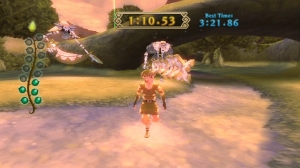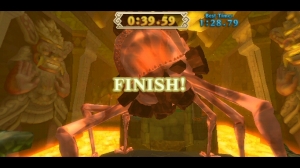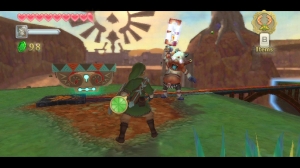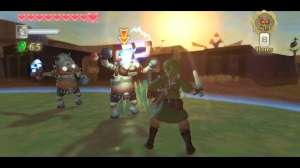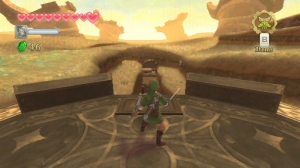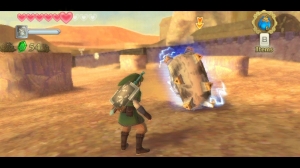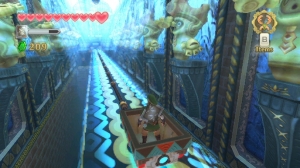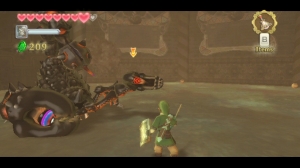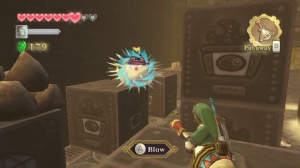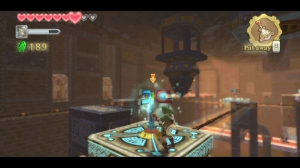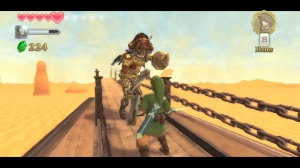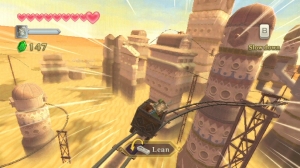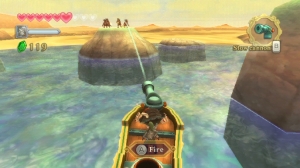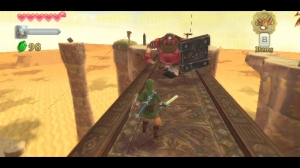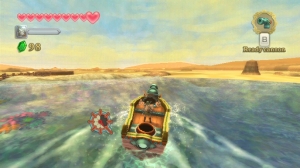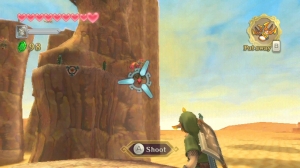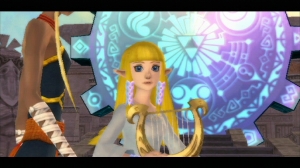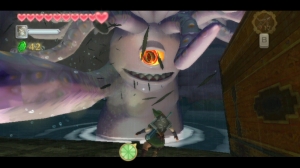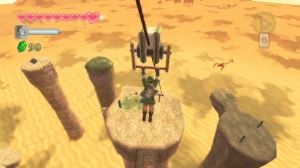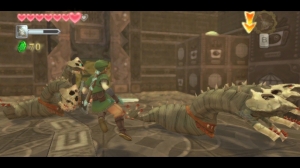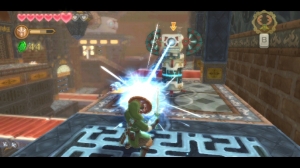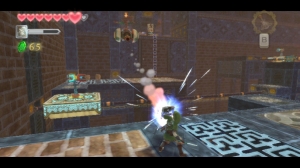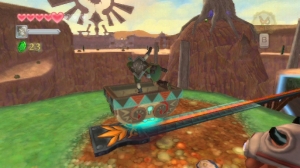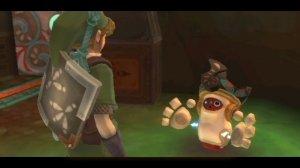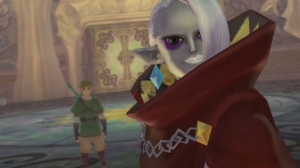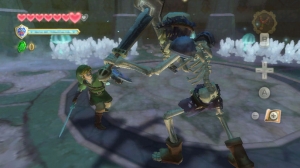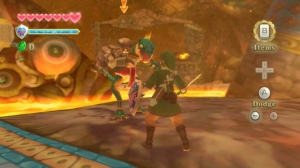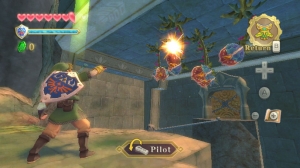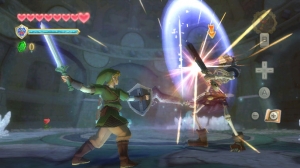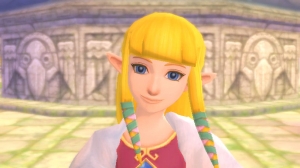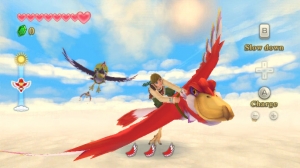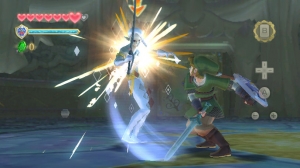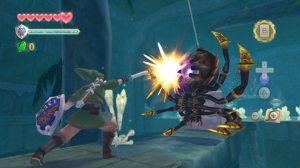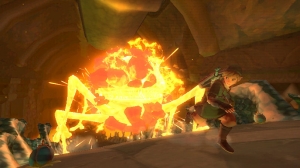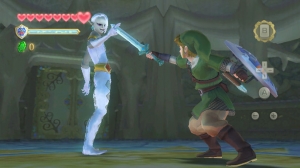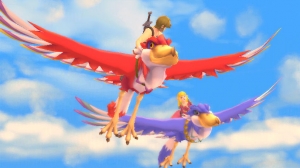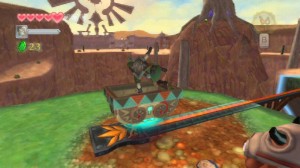 The Legend of Zelda has become more than just a name but is now a legend in itself. Every instalment of the series tries to do something new giving a brand new experience every time. This can be something good like in the case of Ocarina of Time which provided the big shift into the 3d landscape or it can be something bad like in the case of the extensive boat travel found in The Wind Waker. This time around there’s been some drastic changes to the feel of the game making this one of the exciting instalments to come. The most significant new feature would have to be the usage of the Motion Plus accessory that has been touted to provide unparalleled control. Will this instalment of the Zelda franchise be one of the best yet or do we have another Wind Waker on our hands?
The Legend of Zelda has become more than just a name but is now a legend in itself. Every instalment of the series tries to do something new giving a brand new experience every time. This can be something good like in the case of Ocarina of Time which provided the big shift into the 3d landscape or it can be something bad like in the case of the extensive boat travel found in The Wind Waker. This time around there’s been some drastic changes to the feel of the game making this one of the exciting instalments to come. The most significant new feature would have to be the usage of the Motion Plus accessory that has been touted to provide unparalleled control. Will this instalment of the Zelda franchise be one of the best yet or do we have another Wind Waker on our hands?
One of the best launch games that came out when the Wii first arrived had to be Twilight Princess. It was a great game that felt much like an extension of Ocarina of Time. The problem with Twilight Princess though it wasn’t designed specifically with the Wii in mind since it was originally a Gamecube game and released at the same time as the Gamecube version. So the motion controls while were showcases of some the possibilities of what the Wii is capable but it was not the tailored made game that Nintendo fans have been clamouring for. In addition to this the Wii Remote didn’t have the precision you’d need for Link’s sword where slashing with the Wii Remote motion controls were nothing more than a replacement for pressing the A button. Enter Skyward Sword, by far the most exciting game to come out that uses the Wii’s Motion Plus peripheral. When I started playing Skyward Sword I didn’t notice the drastic difference with the level of control you have until I first got my hands on a sword about thirty minutes into the game. This made me appreciate some of the potential of the Wii which has been mostly lacking since it was first unleashed in 2006. With the sensitivity of the Motion Plus the controller can pick up the swipes in whatever direction you happen to be moving the controller. From my experience it’s really accurate and I rarely had it go differently than where I meant for it to go. It was great experience though I still wouldn’t go so far saying it’s gone beyond what traditional controller can do. Instead of the motion controls being just being one action this time around there’s about nine different motions that it can pick up with the Motion Plus. One gripe though is it doesn’t take into account the acceleration of any particular swipe, you’re either swiping or poking forward or you’re not. So in effect the same effect could be created using a second analog stick but the fact you’re swiping in reality does add a lot to the immersion of the game feeling like something fresh despite the motion controls still having not reached its full potential.
Where the motion controls gets kicked to next gear is the strategy involved in sword fighting. The way you combat individual enemies has been changed, where you see the return of many enemies that you’ve seen past games such as Ocarina of Time, The Wind Waker and Twilight Princess. While I don’t want to spoil too much but where you slash is important and how you go about battling these enemies are similar previous games but also totally shaken up. To give one specific example when you battle Moblin (the pig like enemies) they will defend from different stances and you have to slash in a way that they’re not defending which is reminiscent of Punch-Out! save now in an adventure game. This is true for just about any enemy in the game where you must figure out how to defeat them with the new controls. Sword fighting also includes some other stances like charging your sword by holding up the Wii Remote so that you charge a sword projectile like in older Zelda games or doing spin attacks by either moving both the Wii Remote and Nunchuk up and down or left and right. The only problem with the spin attack is the cord sometimes gets in the way.
While the sword fighting is intuitive, I have to complain about flying on my Loftwing (the giant bird that habitants of Link’s home in this installment Skyloft fly upon). There is a tutorial for explaining how the flying mechanics work and while it’s quite simple when you learn that you use the Wii Remote to flap your wings this is never explained in the actual in-game tutorial and feels like a misstep when Nintendo is usually careful to craft their games so that the experience is intuitive. As for other loose ends that I haven’t covered about the game’s controls everything else is quite solid where aiming is quite similar to how it’s done in Twilight Princess which is basically a first person shooter mode. In fact there is a first person mode which you use a detective like mode similar to in the Batman Arkham games to track down what direction you’re supposed to be heading to track down who or what you’re looking for. While there are more items to that I could talk about I’ll leave it you to discover the rest which generally work fine.
There is one addition to the gameplay of Zelda that has nothing to do with motion controls and that’s the addition of a stamina meter. This adds a new layer to the gameplay which you can use to make Link run or be used up by spin attacks. You need to ration some of your more powerful moves or when you need to run. It’s reminiscent of running in first person games otherwise if you use of all your stamina you’re stuck waiting for your meter to recharge. To make going from one destination or another there are stamina recharge items in certain areas that will otherwise be straight forward destinations where it doesn’t make sense to have to ration your meter. While it’s not the biggest addition in the world it’s something new to those that have played tons of Zelda games and appreciate any evolution in the formula that adds yet another layer of depth.
The general formula of Zelda hasn’t changed unlike the changes that have been made to the controls. You still go from dungeon to dungeon collecting a map, key and then fight the boss. The dungeons are still well designed and these are some the most difficult puzzles to be in a Zelda game yet. The paths to each dungeon are also longer than ever before where it’ll take about the same time to get to the dungeon as it takes to complete the dungeon. In essence the overworld feels like another dungeon for you to explore and figure out. There is some new stuff to dig into like the ability to collect materials that you can use to upgrade your different gear and make it better. As you progress new items are made available and your inventory grows, Link can only hold so much so you may have to leave some items behind so you need to figure out what you leave behind. As with other Zelda games there are many side quests for you to dig into like collecting treasures, digging around holes for items and running errands for Link’s friends. The main game clocks in at around 30 hours making it one the longest Zelda games yet.
The presentation is where Skyward Sword feels a little outdated. The graphics are a mix of Twilight Princess and Wind Waker where you’ve got pastel colors which remind of Wind Waker though it has a larger color pallet which reminds of Twilight Princess. Nintendo tried to create a distinctive look but even up converted using a 1080p receiver it can’t help but look like its 6 years behind on the times. While I understand the Wii is just not capable of bringing the same looks on an Xbox or PS3 there are games like Kirby’s Return to Dreamland that take the stylized look and runs with it. However if we’re only comparing to just Wii games and not more advanced consoles the game looks quite good for what the platform is capable of. Now on the other hand I think it’s ridiculous that it’s 2011 and Zelda still doesn’t have any voiceovers for the dialog and you’re still reading the text like we’re still in 1991. It’s about time that we finally hear voices in a Zelda game and make it feel like a current generation game. The one place where the presentation does stand up is the fantastic orchestral soundtrack for Skyward Sword. These beautifully composed orchestral songs are amazing and are up to the standard set by such games as Skyrim and Uncharted 3.
Skyward Sword delivers just about in every level that it needs to. The motion controls are great and a breath of fresh air to keep the Zelda formula fresh after all this time. If you are a lover of Zelda games are ready for something fresh for how a Zelda game is played this is a good bet. While how the game controls is different the formula stays largely the same for better or worse. I’d definitely recommend somebody picking this up if they ever liked a Zelda game, the motion controls might be enough to reignite your love for the franchise. Deep down it’s still a Zelda, but it’s a Zelda game which is awesome itself and with a really fun control scheme.
Gameplay
Graphics
Sound
Overall

